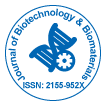Prevention of Pre Clampsia: A Pregnancy Complication by down Regulation of At1-B2 Receptor Heteromers
Received: 18-Oct-2021 / Manuscript No. jbtbm-21-44786 / Editor assigned: 20-Oct-2021 / PreQC No. jbtbm-21-44786 (PQ) / Reviewed: 26-Jan-2022 / QC No. jbtbm-21-44786 / Revised: 28-Jan-2022 / Manuscript No. jbtbm-21-44805 (R) / Published Date: 02-Feb-2022 DOI: 10.4172/2155-952X.1000253
Introduction
Preeclampsia is seen in 7% of pregnant women worldwide. It is a pregnancy complication without any cure. It is the major cause for Morbidity in both mother and fetus. It includes several symptoms like
- High blood pressure after 20 weeks pregnancy
- Signs of damage to another organs
- Kidney dysfunction which leads to proteinuria
Among different symptoms, vascular and systemic angiotensin II hypersensitivity is one of the best-established features of preeclampsia. It is also a disease which predisposes mother and infant to develop cardiovascular diseases in future [1]. An increased plasma level of the anti-angiogenic soluble fms-like tyrosine kinase-1 (sFLT1) is being developed as a diagnostic marker for preeclampsia. However, studies are still going on for the patho mechanicss, which trigger this process. The increased plasma level of sFLT1 is due to enhanced angiotensin IIstimulated signalling; another symptom of preeclampsia, the decrease in vascular RGS5 is related to this. Screening for PE attempts to identify high-risk pregnancies to modify antenatal care and institute preventive treatment regimens in order to reduce complications and deaths. The SCOPE group developed a predictive model for PE based on clinical risk factors for nulliparous women and concluded that screening for PE using maternal history alone is an unreliable method.
Angiotensin II hypersensitivity
It is a consequence or bystander of preeclampsia because the increased protein aggregation between the angiotensin II AT1 receptor and the bradykinin B2 receptor is the root cause of preeclampsia. This situation have been addressed in a transgenic pregnant mice with increased expression of AT1-B2 under SM22-alpha promoter which is specific to smooth muscle. It is observed that the given amount of AT1-B2 was sufficient to develop the symptoms of preeclampsia in those mice. Not only to angiotensin II stimulation but also to pathomechanical stimulation AT1-B2 caused vascular hypersensitivity [2-5]. The role of the angiotensin II hypersensitivity in the treatment of preeclampsia is not known but it contributes to the long-term cardiovascular morbidity of women who have had preeclampsia. Hence a transgenic pregnant mice is taken and in vivo an increased vascular AT1-B2 heteromerization contributes to the angiotensin II hypersensitivity of pregnancies complicated by preeclampsia by an increased angiotensin II-stimulated signaling vascular angiotensin II hypersensitivity was documented ARRB1-S412A prevents symptoms of preeclampsia in pregnant Tg-AT1-B2 mice Placental biopsies from pregnancies complicated by preeclampsia show an increased p-S412-ARRB1 content, increased FOS and decreased RGS5 expression.
Pregnant mice with smooth muscle-specific AT1-B2 expression develop symptoms of preeclampsia
Characterization of pregnancies complicated by preeclampsia is performed by increased vascular AT1-B2 heteromerization. The impact of increased vascular AT1-B2 heteromerization on pregnancy outcome in laboratory conditions is also analysed. The target pregnant Tg-AT1-B2 mice developed symptoms of preeclampsia as evidenced by hypertension on beginning of third week approximately on 18th day of pregnancy, low platelet count, and increased levels of circulating sFlt.
Conclusion
Amlodipine could be used for reducing risk of preeclampsia hypertension. It indicates Amlodipine show no side effects on pregnancy. It can also be used to reduce risk in patients in severe conditions of preeclampsia. Long term action of amlodipine reduces blood pressure and also targets AT1-B2 heteromer-mediated signaling as a characteristic feature of preeclampsia.
Acknowledgement
I would like to thank my Professor for his support and encouragement.
Conflict of Interest
The authors declare that they are no conflict of interest.
References
- KrishnanY, Grodzinsky AJ (2018) . Matrix Biol 71-72: 51-69.
- Kuma A, Ghosh Kadamb, Ghosh Kadamb K (2020: a review article. Arch Bone Jt Surg 8 (5): 560-569.
- Johnson K, Zhu S, TremblayM S (2012) . Science 336 (6082):717-721.
- Fortier LA, JU Barker, StraussEJ (2011) (10): 2706-2715.
- Ashe KW,Kan HM, Laurencin CT (2012). Regen Med 7 (4):535-549.
- Hou Y, Zhang X, Zhou T Liu, (2021. Cell Death Dis 12 (5): 483.
, ,
,
, ,
, ,
, ,
, ,
Citation: Der CV (2022) Prevention of Pre Clampsia: A Pregnancy Complication by down Regulation of At1-B2 Receptor Heteromers. J Biotechnol Biomater, 12: 253. DOI: 10.4172/2155-952X.1000253
Copyright: © 2022 Der CV. This is an open-access article distributed under the terms of the Creative Commons Attribution License, which permits unrestricted use, distribution, and reproduction in any medium, provided the original author and source are credited.
Share This Article
Recommended Journals
51ºÚÁϳԹÏÍø Journals
Article Tools
Article Usage
- Total views: 2652
- [From(publication date): 0-2022 - Apr 30, 2025]
- Breakdown by view type
- HTML page views: 2122
- PDF downloads: 530
